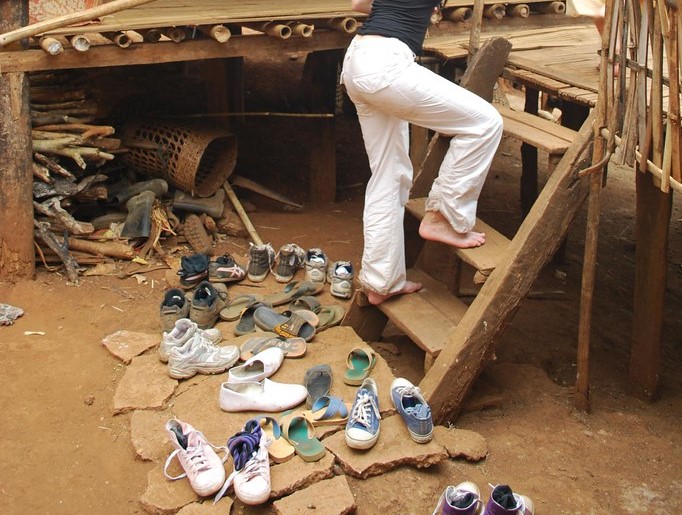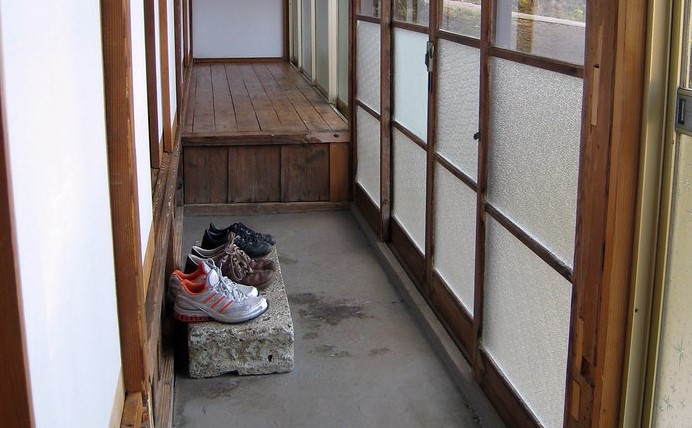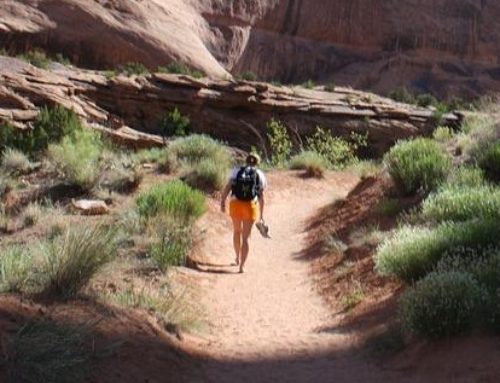
“Dutch girl entering Lahu house” by avlxyz is licensed with CC BY-SA 2.0.
Removing one’s shoes when going from the outdoors to the indoors is common practice in many cultures, although the custom itself varies greatly from one region to another. From India to Japan, this practice still prevails. When entering a temple, someone’s home, schools, and even some places of business, the polite thing to do is remove one’s shoes. No one is certain when the practice began, but the origin of its intention was cleanliness. In times past and in some places still, it was not uncommon for floors to be built above the ground to help keep the weather and animals out. At the same time, it was common to eat and sleep on or near the floor, rather than on furniture. In Japan, people will sleep on a futon or tatami on the floor, put it away during the day and eat a communal meal while sitting on pillows in that same space. This is so incorporated into daily life that most homes and businesses have a “genkan”, a small entryway for removing one’s shoes and it’s typical to see shoes and sandals stacked on shelves and cubbies to one side. So, while we don’t see chickens or goats running around outside our homes and businesses as much anymore, there are still plenty of dogs, cats, and birds who are doing their business on the ground that the bottom of your shoes spend all day walking around on. In fact, Dr. Charles Gerba, microbiologist and professor at the University of Arizona, recently published a study that found there are large numbers of bacteria both on the bottom and inside of shoes.
“The common occurrence (96 percent) of coliform and E. coli bacteria on the outside of the shoes indicates frequent contact with fecal material, which most likely originates from floors in public restrooms or contact with animal fecal material outdoors,” said Gerba. “Our study also indicated that bacteria can be tracked by shoes over a long distance into your home or personal space after the shoes were contaminated with bacteria.”
Contact with these kinds of contaminants can contribute to illness. Some of the bacteria found on the shoes can cause intestinal and urinary tract infections, meningitis, and diarrheal disease. This is both the history of and the reason for the custom of removing one’s shoes before setting foot on a Judo tatami (mat). Our dojo mat is elevated above the reception area floor and students need to remove their shoes, and presumably their socks, before stepping on the mat where our faces will be near while practicing Ukeme, Nage-waza and Randori.
Conversely, it is equally important that some sort of footwear is worn when stepping off the mat. In Japan, it is not uncommon for a host to offer guests slippers when need presents itself. I’ve heard a few funny stories of embarrassed hosts who did not have slippers large enough for their American guests. Likewise, it is important that students wear flipflops, sandals or slippers when stepping off the dojo mat, even if just getting a drink, or especial if going to the bathroom. It’s not just traditional Judo dojos that feel this way. Most Martial Art gyms have this or a similar policy. Preventing skin infections is serious business when athletes are in such close contact. The National Athletic Trainers’ Association has published a position statement on skin diseases that include these seven preventive measures:
- Organizational support must be adequate to limit the spread of infectious agents.
- A clean environment must be maintained in the athletic training facility, locker rooms, and all athletic venues.
- Health care practitioners and athletes should follow good hand hygiene practices.
- Athletes must be encouraged to follow good overall hygiene practices.
- Athletes must be discouraged from sharing towels, athletic gear, water bottles, disposable razors, and hair clippers.
- Athletes with open wounds, scrapes, or scratches must avoid whirlpools and common tubs.
- Athletes are encouraged to report all abrasions, cuts, and skin lesions to and to seek attention from an athletic trainer (AT) for proper cleansing, treatment, and dressing.
Responsible dojos and gyms, like mine, have policies that address these safety issues and they are ingrained into their culture. Not only is it good manners to keep your feet and hands clean, but it also helps prevent the spread of infectious diseases. That’s why it will remain our policy, even after we relax our COVID policies, to encourage students to continue wash their hands when they arrive on the dojo mat and wash them again before they leave.

“Genkan and Engawa” by Michael Cornelius is licensed with CC BY-SA 2.0.
I expect students to arrive clean (regularly bathed, without body-odor), with their fingernails trimmed and their feet clean with toenails trimmed. If a student wishes to put on clean socks while on the mat, that is their choice, but socks can be slippery. I’ll do my part to make sure the dojo mat, floors, and equipment is properly and regularly cleaned and disinfected.
Besides having a clean body, students should wear clean training attire. Not all our classes require a Gi (i.e. “judogi”; the traditional training attire used in Judo that is comprised of pants or “shitabaki “, a kimono-style jacket called a “uwagi “and a belt called an “obi”), but whether in a Gi, Yoga pants, or athletic shorts, students attire should be clean and odor free. While it is permissible to arrive already dressed in one’s Gi, it is not generally recommended to wear them outside where they may get dirty. Students should wear a clean Gi for each practice and wash their Gi after each practice. Care of one’s Gi has long been such an important practice in Judo that the founder of Judo, Jigoro Kano, included a section on “how to properly fold a Gi” in his manual Kodokan Judo. Gi’s should not be thrown in unkept wads, rather Gi’s must be folded properly and kept in a Gi bag or other gear bag. Students who forget these guidelines and forget their manners will be reminded directly. Let’s work together to make it everyone’s diligent practice to promote the safety and cleanliness of our dojo and the prevention of illness a part of our academy’s culture.






